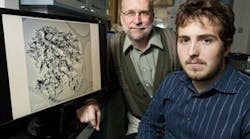Iron-impregnated carbon spheres promise simultaneous removal of pollutants such as nitric oxide, mercury and dioxin from gas streams by combining carbon's adsorption properties with iron's reactivity, say researchers at the University of Illinois, Champaign, Ill. They now have developed a process that simplifies making such materials.
A team led by Mark Rood, professor of civil and environmental engineering, and graduate student John Atkinson have created a continuous single-step process using so-called ultrasonic spray pyrolysis (USP). It yields highly porous carbon spheres containing well-dispersed iron nanoparticles in a matter of seconds.
Rather than using coal as the source of carbon, the process relies on sucrose. A solution of sucrose, an inorganic salt and an iron salt is turned into an aerosol ultrasonically and then pyrolyzed. This dehydrates the sucrose to carbon and converts the iron salt to iron. The 0.5–3-micron-dia. spheres produced contain 4–90-nm iron nanoparticles. The researchers have achieved surface areas as great as 800 m2/g and iron loadings up to 35 wt.%.
"Some people have carbonized and impregnated with iron, but they have no surface area. Other people have surface area but weren't able to load it with iron," says Atkinson. "Our technique provides both the carbon surface and the iron nanoparticles."
"We can readily change this new material by how it's activated to tailor its surface area and the amount of impregnated iron. The method is simple, flexible and tailorable," adds Rood.
"We can, to a large extent, control the physical and chemical properties of the carbon supports and the metal nanoparticles by varying the composition of the precursor solution and the processing conditions in the reactor," he explains.
The researchers ultimately would like to replace sucrose -- which isn't particularly cheap, they admit -- with a carbon-rich industrial waste material. They also are interested in using the USP process to impregnate carbon with nanoparticles of metals other than iron. "Our current target is gas-purification applications. However, numerous applications such as catalytic reactors to produce chemical products are certainly a possibility," adds Rood.
The team, which is collaborating with researchers in Taiwan, now is working under two multi-year grants from the National Science Foundation to develop carbon-based catalytic materials to remove nitric oxide, mercury and dioxin.
If bench-scale tests go as hoped, pilot-scale trials may take place within the next two to three years, says Rood. A gas-purification company already has expressed interest in collaborating on the development. "If all goes well, materials for commercial use might be available within four to five years," he reckons.

